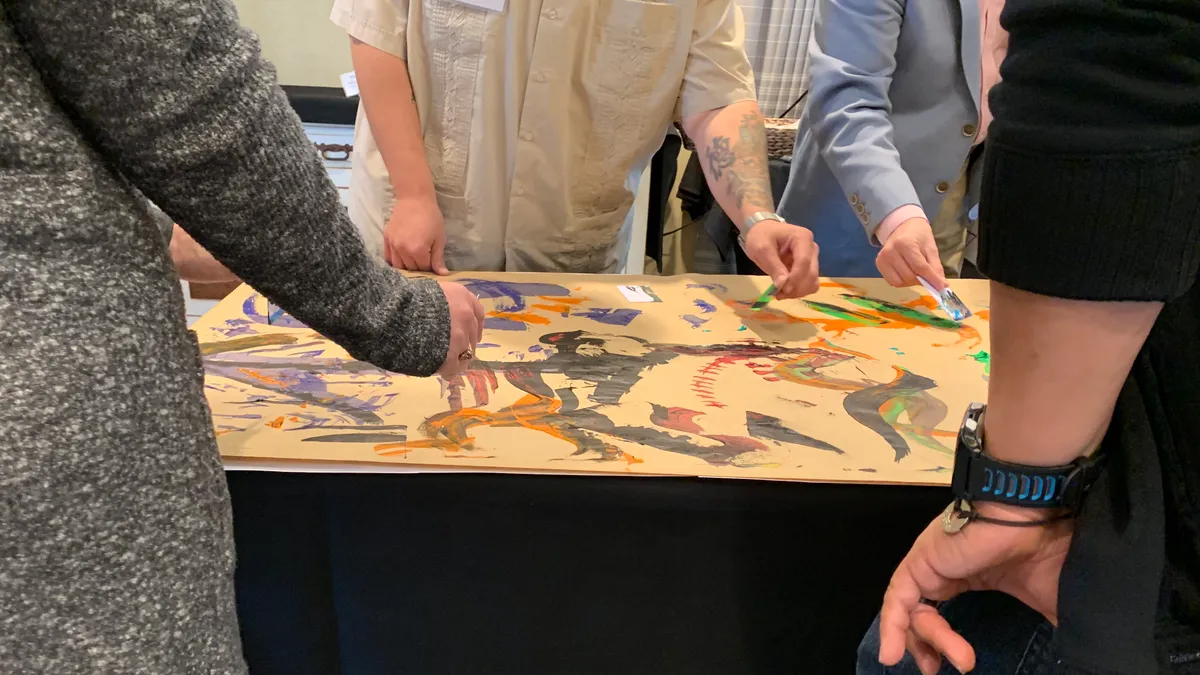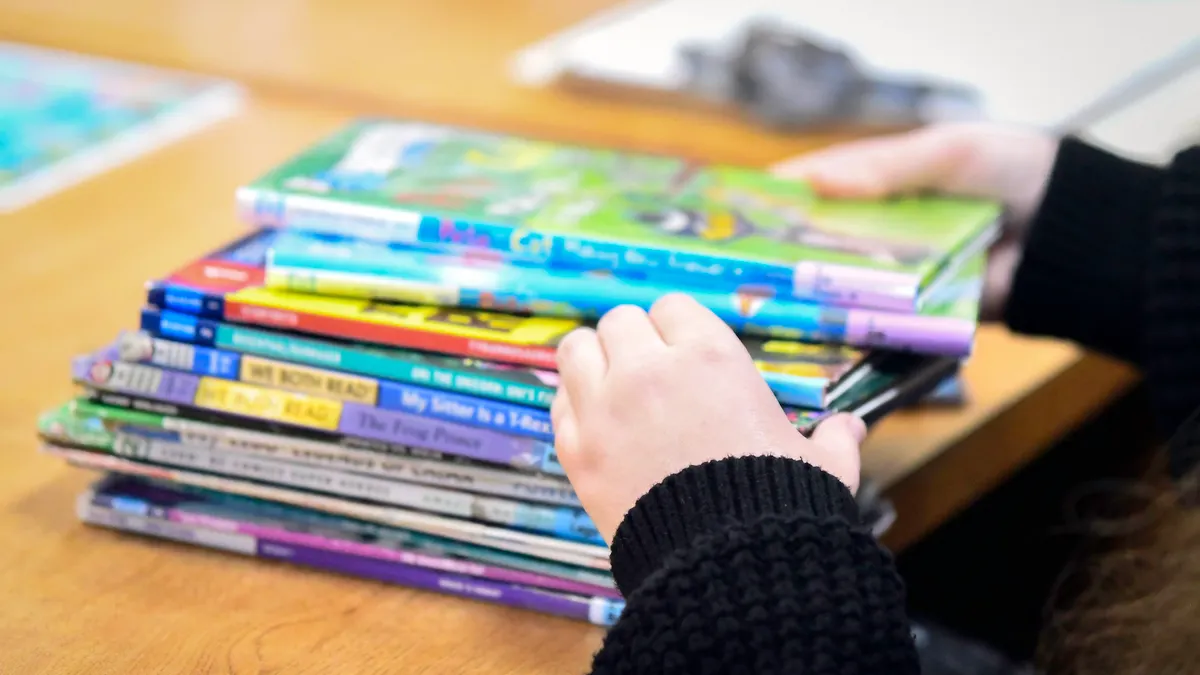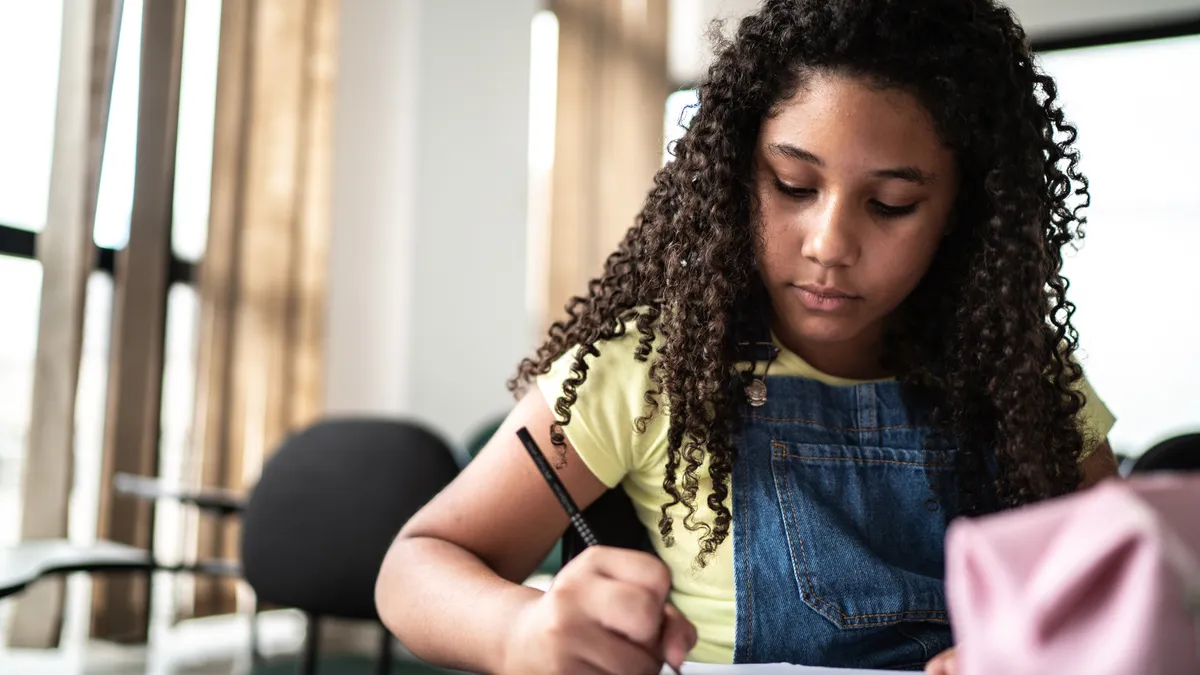HUNTINGTON BEACH, California — Dipping business- or credit-sized cards into blobs of acrylic paint, the principals begin to create sweeping designs on the mural-length sheet of butcher paper stretched across long tables. As they circle the table, they blend the colors together, then place Post-it notes with key words from the book chapters they were assigned to read the previous evening on top of their creation.
Called “scrimming,” the hands-on — or, as some said, almost therapeutic — technique is a way to capture important terms from a text and make a thorough read more productive. A blend of skimming and scrim, a fabric used in theater that appears opaque until light shines through, the practice is one these principals from across California say they would encourage teachers to use with students as a close reading strategy.
“It’s a way to home in on vocabulary,” one principal says.
“It clears the head,” adds another.
As part of Turnaround Arts: California — which is connected to a larger, national Turnaround Arts network — these administrators lead some of the lowest-performing schools in the state. And leaders are reviewing the newly released list of schools in the bottom 5% in planning for expansion.
Through retreats like this and ongoing expertise from Turnaround Arts staff members, however, administrators receive guidance on how to make the arts a more prominent part of their school improvement plans and grow student opportunities in this area.
Viviana Espinosa, principal of Costaño School and the 49ers Academy in East Palo Alto, California, said being part of the network has also helped her broaden her work with local organizations in the community.
“It’s pretty powerful,” she said, “and as principals, we don’t always have time to connect to resources.” She later added that while being part of a national group based at the John F. Kennedy Center for the Performing Arts in Washington doesn’t mean much to parents, giving them opportunities such as family arts nights and seeing their children present their work has stirred more enthusiasm for the program.
'A slow-moving machine'
The Every Student Succeeds Act (ESSA) defines student success as more than just achievement in core academic subjects and lists the arts and music as examples of a “well-rounded education.” But few states have formally incorporated the arts into their accountability systems.
“It has been a slow-moving machine,” Jane Best, director of the Arts Education Partnership (AEP), said in an interview. When ESSA was passed in late 2015, she said, arts educators’ eyes were “wide open” to the possibilities the new law created, “but they still didn’t know how to insert themselves into the conversation.”
So far, only Illinois includes the arts as a distinct indicator in measuring school quality from pre-K through 12th grade. The fine arts count as a school quality indicator and will be given "equal footing" with measures such as school climate surveys, Jonathan VanderBrug, policy and research director of the Arts Alliance Illinois, said in an interview.
“It embodies the part of ESSA that says, 'Let’s look at new things that have always been fundamental to success,'” he said. The organization worked as part of a year-long process to make sure arts education was not just optional in the accountability plan. The state Board of Education “heard the voice of the arts community and included it,” VanderBrug said.
But because “that’s really new territory,” he added, the category is currently weighted at 0% while the state considers a plan for how to assess a school’s arts programs. The proposed three-part measure, which the board could decide on in the next few weeks, would include how many students are participating in the arts, whether teachers have an endorsement in the discipline they teach, and, finally, a student perception survey on the arts.
Karla Rivera, the director of public affairs for Ingenuity, a nonprofit that analyzed data for the Illinois Arts Indicator Work Group, said in an interview that as she talks to colleagues in other states, she hears reluctance toward using the arts as an indicator on their own. But she said if the Illinois board adopts the proposal, that might “catalyze other states to say, ‘Yes, it can be done.’”
Giving ‘vital skills to students’
A growing list of studies support the argument that the arts can improve both students' academic and non-academic outcomes. Released earlier this month, a report from the Houston Education Research Consortium, for example, showed art education reduced the proportion of students in the Houston Independent School District receiving disciplinary infractions by 3.6% and improved students' writing achievement and compassion. Elementary school students were also more engaged, aspired to attend college and valued the arts.
Another recent study found incorporating visual and performing arts into STEM instruction can increase students’ scores in science. Other studies have found academic benefits of arts-related field trips. And last week, the AEP released a post on how the arts are being integrated into career and technical education programs.
A 2017 report from the Wallace Foundation identified 12 funding streams through ESSA that could be used to support arts integration and 44 types of arts-related interventions or programs that would meet the law’s criteria for using models supported by research. According to a summary of the report, “There are no ESSA funds earmarked for arts integration ... so applicants must clearly explain how their proposed arts-integration interventions relate to their broader goals for their schools.”
But members of the arts community would like to see more value placed on the arts themselves, not just because they might increase scores in other content areas. “In and of themselves, they give vital skills to students,” VanderBrug said.
'Telling that bigger story'
Connecticut also explicitly names the arts as part of the state’s accountability system — but not at all grade levels. Schools and districts get credit for the percentage of high school students participating in at least one dance, theater, music or visual arts course each year, according to Peter Yazbak, a spokesman for the Connecticut Department of Education. Beginning with the graduating class of 2023, high school students will also be required to earn nine credits in the humanities, including one in fine arts. The Meridan Public Schools is one district in the state that has received attention for tying expansion of the arts to accountability indicators.
Under Kentucky’s new accountability system, visual or performing arts can count as an academic measure under the state’s “transition readiness” indicator, which is meant to support “the development of students who are well-rounded, transition-ready and prepared with knowledge, skills and essential dispositions to succeed in the next educational setting or career pathway.” Annual “school profile reports” also include information on schools’ arts programs.
In Illinois, the new accountability plan hasn’t necessarily motivated schools to add more arts programs, VanderBrug said, noting that instead it’s a way to give schools credit for what many are already doing. “It’s part of telling that bigger story,” he said.
In Chicago specifically, Rivera said there has been a 128% increase over the past five years in schools with “strong” or “excelling” arts programs, as measured by the district’s Creative Schools Certification rubric. Two-thirds of the district’s students also attend a school reaching those top two categories, she said.
‘Addressing it through the arts’
At their retreat, funded with a grant from the Stuart Foundation, the California principals also shared some obstacles they’re facing, such as veteran teachers who don’t want to try anything new, novice teachers who don’t want to take the lead, and union contracts stating schools can’t force teachers to attend a professional development session.
Cristy Campanaro, principal of Marina Vista Elementary in Monterey, California, said her district is also frequently directing her to offer another PD opportunity or participate in another initiative related to a district goal.
“As a leader, I need to say, ‘I know this is one of our priorities; we are addressing it through the arts,’” she said during a protocol, in which principals talked in groups of three about their challenges and successes.
Ryan Ramirez, principal of Sierra Preparatory Academy in Santa Ana, California, said he hopes to increase his faculty’s support for integrating the arts into their lessons by surveying teachers and students on cultural and arts-related events, exhibits or other opportunities in the community that they’d be interested in visiting. Parent leaders, he said, could handle a lot of the coordination.
Malissa Shriver, co-founder and president of Turnaround Arts: California — who now hopes to expand the model to Wyoming — said in an interview that when it comes to the arts, she still sees hesitation among educators, left over from No Child Left Behind’s more compliance-oriented approach.
“When we started, I said, ‘We’re not taking Title I money for arts education; we’re using the arts to help you accomplish your Title I goals,’” she said. Now, with the nationwide focus on social-emotional learning (SEL), she’s working with researchers at the University of California, Los Angeles to plan a spring symposium on how the arts can support SEL. “There are so many ways to think about it as a humane and loving approach to education.”






 Dive Awards
Dive Awards















